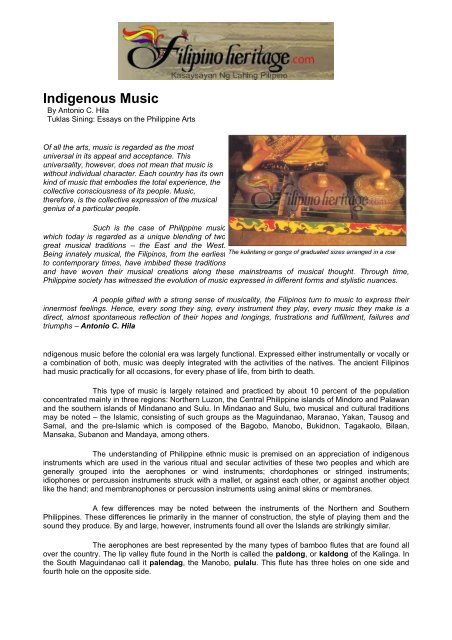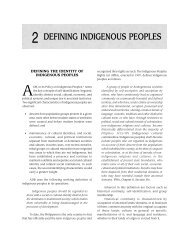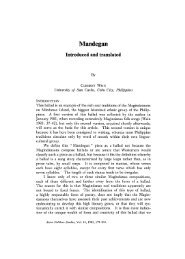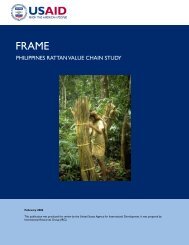Indigenous Music - Philippine Culture
Indigenous Music - Philippine Culture
Indigenous Music - Philippine Culture
You also want an ePaper? Increase the reach of your titles
YUMPU automatically turns print PDFs into web optimized ePapers that Google loves.
<strong>Indigenous</strong> <strong>Music</strong><br />
By Antonio C. Hila<br />
Tuklas Sining: Essays on the <strong>Philippine</strong> Arts<br />
Of all the arts, music is regarded as the most<br />
universal in its appeal and acceptance. This<br />
universality, however, does not mean that music is<br />
without individual character. Each country has its own<br />
kind of music that embodies the total experience, the<br />
collective consciousness of its people. <strong>Music</strong>,<br />
therefore, is the collective expression of the musical<br />
genius of a particular people.<br />
Such is the case of <strong>Philippine</strong> music<br />
which today is regarded as a unique blending of two<br />
great musical traditions – the East and the West.<br />
Being innately musical, the Filipinos, from the earliest<br />
to contemporary times, have imbibed these traditions<br />
and have woven their musical creations along these mainstreams of musical thought. Through time,<br />
<strong>Philippine</strong> society has witnessed the evolution of music expressed in different forms and stylistic nuances.<br />
A people gifted with a strong sense of musicality, the Filipinos turn to music to express their<br />
innermost feelings. Hence, every song they sing, every instrument they play, every music they make is a<br />
direct, almost spontaneous reflection of their hopes and longings, frustrations and fulfillment, failures and<br />
triumphs – Antonio C. Hila<br />
ndigenous music before the colonial era was largely functional. Expressed either instrumentally or vocally or<br />
a combination of both, music was deeply integrated with the activities of the natives. The ancient Filipinos<br />
had music practically for all occasions, for every phase of life, from birth to death.<br />
This type of music is largely retained and practiced by about 10 percent of the population<br />
concentrated mainly in three regions: Northern Luzon, the Central <strong>Philippine</strong> islands of Mindoro and Palawan<br />
and the southern islands of Mindanano and Sulu. In Mindanao and Sulu, two musical and cultural traditions<br />
may be noted – the Islamic, consisting of such groups as the Maguindanao, Maranao, Yakan, Tausog and<br />
Samal, and the pre-Islamic which is composed of the Bagobo, Manobo, Bukidnon, Tagakaolo, Bilaan,<br />
Mansaka, Subanon and Mandaya, among others.<br />
The understanding of <strong>Philippine</strong> ethnic music is premised on an appreciation of indigenous<br />
instruments which are used in the various ritual and secular activities of these two peoples and which are<br />
generally grouped into the aerophones or wind instruments; chordophones or stringed instruments;<br />
idiophones or percussion instruments struck with a mallet, or against each other, or against another object<br />
like the hand; and membranophones or percussion instruments using animal skins or membranes.<br />
A few differences may be noted between the instruments of the Northern and Southern<br />
<strong>Philippine</strong>s. These differences lie primarily in the manner of construction, the style of playing them and the<br />
sound they produce. By and large, however, instruments found all over the Islands are strikingly similar.<br />
The aerophones are best represented by the many types of bamboo flutes that are found all<br />
over the country. The lip valley flute found in the North is called the paldong, or kaldong of the Kalinga. In<br />
the South Maguindanao call it palendag, the Manobo, pulalu. This flute has three holes on one side and<br />
fourth hole on the opposite side.
There is also the popular nose flute, which produces soft and soothing sounds heard clearly in<br />
quiet late afternoons. The northern tribes call this kalleleng (Bondotc and Kankanai), tongali (Ifugao and<br />
Kalinga) and baliing (Isneg). In the Central <strong>Philippine</strong>s, it is known as lantuy among the Cuyunin, babarek<br />
among the Tagbanua and plawta among the Mangyan.<br />
In addition, some aerophones are composed of several bamboo tubes of different lengths, like<br />
the Kalinga saggeypo and the diwdiw-as, a panpipe common to Igorots. The diwdiw-as is made of five or<br />
more slender bamboo tubes tied together. The upper ends of the tubes are open and into these a performer<br />
blows without his lips touching the instrument. On the other hand, the six saggeypo tubes are left untied and<br />
may be played by a group of people. The simultaneous blowing of the pipes results in harp-like sounds.<br />
The Maguindanao, meanwhile, have the suling or ring flute, so called because the blowing<br />
end is encircled with a rattan ring to create mouthpiece. The Tausog have a six hole single-reed sahunay,<br />
with its characteristic cone-shaped pandan-leaf bell.<br />
Chordophones also bound in many parts of<br />
the Archipelago. These include the bamboo zithers, the<br />
Spanish guitars, the bamboo violins and the lutes.<br />
The zither is a stringed instrument made from<br />
a single bamboo section, around three to four inches in<br />
diameter, with a node at each end. Serving as strings,<br />
however, are raised narrow strips of the outer skin fibers of<br />
the bamboo itself, with the ends still attached to the body of<br />
the instrument. Small wedges are placed beneath the strings<br />
to produce different tensions – and thus varying pitches – as<br />
the player plucks the strings.<br />
Variations of the zither can be found all over<br />
the country, like the Ilongot kolesing or the Ibaloi kalshang, the Negrito pas-ing and Ifugao patting; in the<br />
central <strong>Philippine</strong>s, the Tagbanua play the pa’gang, while the Mangyan have the kudlung. The southern<br />
zither is called tawgaw (Bagobo).<br />
Two-stringed lutes knows as the kudyapi among the Bukidnon, hegalong among the T’boli or<br />
the kadlong or kudlong in Central Mindanao are characterized by a boat shape or an elongated oval<br />
between 40 to 45 inches long, and have tightening rods made of wood and frets of beeswax and two-wire<br />
strings tuned in unison – one serving ad drone, the<br />
other providing the melody.<br />
These long “guitars” or boat lutes are<br />
carved in soft wood usually to represent a mythical<br />
two-headed animal, the naga (serpent) or crocodile,<br />
or perhaps the modified head, body and tail of the<br />
sarimanok, a cockerel-like bird. The kudyapi is alos<br />
known as a “speaking instrument” because it figures<br />
prominently in courtship. It is also used as an<br />
accompaniment for dances.<br />
Examples of chordophones using bows<br />
are the three-stringed gitgit of the Tagbanua, the<br />
spike fiddle called duwagey of the Bilaan and the<br />
biola of the Tausog, which is similar to the European<br />
violin used to accompany songs.<br />
Perhaps the greatest number of indigenous musical instruments belong to the idiophone<br />
group. In particular, some of these idiophones are the jew’s harp, suspended beams, bamboo buzzer,<br />
percussion sticks and gongs.<br />
The jew’s harp is a very thin slit of bamboo or brass with a narrow vibrating tongue in the middle longitudinal<br />
section. Placed between the lips of the player, its tongue is made to vibrate by striking the projecting end of<br />
the instrument with the thumb or by pulling a string attached to it. The mouth of the player acts as the<br />
resonator, and as the shape of the mouth cavity changes, the pitch and quality of the sound varies. This<br />
enables the player to communicate message with his instrument. For this reason, the jew’s harp is a favorite<br />
of lovers and is played by both men and women. It is thus considered a “speaking intrument”.
The jew’s harp is found in many tribes. The<br />
Maranao call it kubing, the Tingguian, kolibau, and the<br />
Tagbanua, aru-ding. The jew’s harp of the South usually have<br />
handles carved with various serpent designs and other scrolllike<br />
patterns, and sometimes punctuated by head bangles and<br />
tassels as in the Maranaw kubing.<br />
Suspended beams like the kagul may be found<br />
only in such groups as the Tiruray and the Yakan of Mindanao.<br />
The kagul consists of five logs ranging from two to two-and-ahalf<br />
meters long which are shaped and pointed at the playing<br />
end. It is played by two people: one plays in the middle of the<br />
log a repeated rhythmic pattern or ostinato, while the second<br />
player beats out a melody at the pointed ends of the other logs. The logs are tuned relative to each other.<br />
Another idiophone, the bamboo buzzer is known variously as the balingbing or bunkaka<br />
(Kalinga) and batiwtiw (Central <strong>Philippine</strong>s). The bunkaka, as the name implies, is a bamboo tube which is<br />
open or split at one end. Sound is produced by striking the split end against the palm. This instrument is<br />
played alone or in groups as a form and diversion or to drive away evil spirits along a forest trail.<br />
Percussion sticks are common to the North and South, like the Ifugao bangibang, and the<br />
Mangyan kalutang.<br />
The bangibang is a row of sticks played only in the rituals for curing very serious illness<br />
and in death ceremonies. The instrument is composed of<br />
sticks measuring from one to two-and-a-half feet long with<br />
diameters ranging from one to three inches, hanging from a<br />
string which also serves as a handle. A stick is used to beat<br />
them in rhythm. Sometimes, however, only two sticks are<br />
used, which are played by striking one against the other.<br />
The well-known gong is found throughout the<br />
tribes in varying<br />
forms. All gongs in the South have a boss, a<br />
deep or shallow mound resembling a kettle or a pan on the<br />
top middle portion of the gong, the rims of which angle<br />
slightly inward. They may either be suspended or laid<br />
horizontally in a row. In the North, a flat gong called gangsa<br />
is widely regarded as the most valued instrument. The<br />
agung, a large gong with boss, is known to both the<br />
Tagbanua of Palawan and Mangyan of Mindoro. The<br />
Magindanao also use a gong called agung, which is played<br />
like a brass tom-tom by striking the boss or knob with a<br />
padded and rounded stick.<br />
In the South, the gong may be used as a<br />
rhythmic counterpoint<br />
to the drum (Tagbanua), as an<br />
accompaniment to an ensemble of gongs called the<br />
kulintang (Maguindanao and Maranao) or with other agungs<br />
(Bagobo) producing an ostinato rhythm and melody to<br />
accompany the dances.<br />
The kulintang, or gongs in a row, is basically a<br />
melody instrument played by a single performer as a solo instrument<br />
or as part of an ensemble. It consists of<br />
eight gongs placed horizontally in a frame and tuned to a flexible pentatonic or five-tone scale. Among the<br />
Islamic peoples of the South of the kulintang ensemble, where it is the primary melody instrument supported<br />
by the dabakan (A conical drum), agung, gandingan (four suspended narrow-rimmed gongs), babandil<br />
(small gong, sometimes the last gong of the kulintang) – all of which act as drones constantly repeating a<br />
particular rhythmic pattern for the duration of the music. The kulintang player acts as the central player and<br />
makes various improvisations on the chosen mode moving in progressively ascending and descending steps<br />
of sounds. Usually, three types of rhythmic modes are utilized, namely, the duyug, sinulug and tidtu. The<br />
dabakan starts with the music, announcing the mode, while the other instruments follow.<br />
The kulintang ensemble is often considered as the most cultivated of the region’s musical<br />
expressions. Aside<br />
from being a medium of entertainment and hospitality, the kulintang also serves as a<br />
vehicle for social interaction and group solidarity and for learning ethical principles.
Other idiophones of the South include the gabbang or bamboo xylophone of the Tausog of<br />
Sulu, and the edel or log drum, a plank idiophone made of molave wood suspended and beaten with sticks<br />
and used by the Tabakaolo, Bilaan and Manobo.<br />
Probably the most important and best known membranophones of the North are the two<br />
conical drums of the Ibaloi – the sulibao and the kimbal. The sulibao has a higher pitch than the kimbal and<br />
is played with a padded stick. Usually, however, these instruments are joined by two other pairs of<br />
idiophones in the sulibao ensemble, namely, the kalsa and the pinsak, which are two flat gongs, and the<br />
palas which are two short iron bard handled by a single player. Similar types of drums exist in the South<br />
such as the dabakan of the Maguindanao and the dadabuan of the Maranao. In addition to these conical<br />
drums, cylindrical types of drums are exemplified by the tambul of the Maguindanao and the gimbal of the<br />
Tagbanua.<br />
Like the instruments, vocal music expresses and transmits in a concrete and vivid manner a<br />
great variety of the thoughts, beliefs, customs, lifestyles, temperament and way of life of the indigenous<br />
peoples. Singing is a main component of life among them. There will be songs and singers, singing solo or in<br />
leader-chorus style with or without accompaniment, with or without the benefit of words (the latter includes<br />
whistling, a highly developed musical from among the Maguindanao of Mindanao).<br />
Solo and leader-chorus singing is done in the North, notably in such groups s the Bontoc,<br />
Ibaloi, Kalinga and Negrito. In the South, on the other hand, while unaccompanied singing seems to be the<br />
predilection of a majority of the indigenous groups, a kind of singing done with instrumental accompaniment<br />
is practiced among certain groups, like the Tausog, who sing with their gabbang (bamboo xylophone) and/or<br />
biola.<br />
Both types of singing – the leader-chorus and singing with instrument – may be found in the<br />
Central <strong>Philippine</strong> groups such as the Mangyan and Tagbanua, where often singing is done with the flute<br />
(Tagbanua), the guitar or violin (Mangyan), either solo or as a group with a soloist-leader.<br />
One may be observe a highly divergent and seemingly endless variety of styles and traditions<br />
of singing in the northern, central and southern <strong>Philippine</strong> indigenous communities. For example, the Kalinga<br />
of the North generally sing in short phrases frequently broken by rests or stops; the Maguindanao of the<br />
south sing in long melismatic phrases; the Mangyan sing mostly in a monotone with turns at the end of<br />
phrases.<br />
Viewed as a whole, certain patterns and<br />
characteristics of singing emerge among these groups. First,<br />
improvisation seems to be the rule in song creation. In fact<br />
the quality of the song and the singer if often measured by<br />
his/her ability to improvise fluently and creatively. Second,<br />
there is generally a low and limited range of notes (more or<br />
less an octave) and within this range, a great number of<br />
uncertain pitches, speech-like sounds, slides, shakes,<br />
tremolos or trills are often added to bring about some<br />
flexibility and richness in the singing despite the narrow<br />
range. Third, melodic ornamentations such as the glissandos,<br />
slides and tremolos are not only accessory but principal<br />
elements in music because they may even determine the<br />
structure of a song. Fourth, since everyone is a singer, there<br />
is a greater variety of voice quality due to differences in age,<br />
sex or cultural factors (e.g. the Manobo sing in a more<br />
relaxed manner and with more embellishments than the<br />
Tiruray). Fifth, a wide variety of scales may be observed. The<br />
scale, however, is, often treated as a flexible structure upon<br />
which equally important elements are embedded to adorn the<br />
scale and render it less obvious. Sixth, while decrescendos<br />
and crescendos (gradual decrease and increase in volume,<br />
respectively) and up and down movements may be noted in<br />
the singing styles of some groups especially in the South, a<br />
syllabic chant-like monotone singing prevails in<br />
many groups. Chanting utilizes the vocal range of a singer<br />
which is most consistent with his natural speech melody. This is the reason why sometimes it is difficult to<br />
discern whether a particular enunciation is sung or uttered. Seventh, there are no exact time elements that
limit the existing vocal forms. Songs create an impression of remarkable rhythmic freedom, with the rhythm<br />
and speed of singing often governed by the language and text of the chants. The frequent use of tremolos<br />
and long-held notes highlight the fact that there is no effort to reach a climactic utterance or a strong<br />
rhythmic drive. Eighth, a large number of reiterated and marked accents on one vowel (eee ~ 000 ~ uuu)<br />
may be noted in the singing of the song texts of the chants. Ninth, in the leader-chorus type of singing,<br />
instead of harmonic chords, a leader may simply give an introductory, monodic "intonation" which the others<br />
follow in a quasi-canonic manner, making use of imitation and singing in unison.<br />
There are many different vocal forms with specific names and uses, each one with a particular rhythm<br />
of its own. Songs mark every stage of human development from birth and infancy to adulthood and death,<br />
night and day, and many occasions in the cycle of natural events and the flow of human activities whether<br />
personal, social, economic, political, spiritual or cosmic. Songs that pertain to the life-cycle of an individual<br />
are the Kalinga appros, sung for half a day after the child's birth and the luguh maulud of the Tausog,<br />
which is sung to celebrate the birth of Mohammed. There are many kinds of children's songs such as the<br />
Kalinga kawayanna for the tying of the child's first necklace; the Maranao bakbato and the Tausog lia-lia.<br />
There are countless lullabies, among which are the chag-ay sa maseypan of the Bontoc the iyaya of the<br />
Mangyan, the binua of the Badjao. There are also the adolescent songs - the Bontoc ayegka, sung for<br />
visiting friends and the Maranao kasingbaga~kanada~tudatu ago kanbaibai, group singing by boys and<br />
girls.<br />
There are genealogical chants, courtship songs by adolescents and love songs for adolescents and<br />
love songs for adults - the Kalinga ading, the Tingguian inegegkak si labago and the Tausog sindil, a dialogue<br />
song described as a song of insinuation. There are songs related to marriage like the Tingguian ricepounding<br />
song imma-isa-i-isa and the nan-sob-oy (Sagada) which is chanted at the conclusion of the<br />
wedding ceremonies. The Maranao sarongkawit is a girl's song of displeasure on a marriage proposal,<br />
while the lakitan tells of a boy's request that his mother propose marriage to a girl he fancies.<br />
And of course, death and the spirit world bring to the fore a big collection of songs on death and the<br />
burial rituals, like the Maranao dikir, a funeral or wake song, and the an-nako, a Bontoc song for funerals<br />
occasioned by natural death. The lbaloi too have their ba-diw, which uses a leader-chorus type of singing<br />
during "death watches", centering on the character and activities of the deceased and the hope of gaining<br />
favors for the living from the spirit-relatives.<br />
Besides songs relating to th e lifecycle, there are also<br />
work songs. These include the Bontoc ayoweng, a field work<br />
song and the soweey, a song for rice-pounding; flalok to<br />
sawa, a Bilaan harvest song which helps harvesters forget<br />
the heat and thus work faster; hunting songs; narrative songs<br />
for entertainment and relaxation during the evenings and also<br />
for the entertainment of visitors, such as the tenis-tenis, an<br />
impromptu Samal song of four-line stanzas with an a,a,a,a<br />
rhyme whose words often joke or chide those present, or<br />
simply tell stories; songs for the blessing of a new house;<br />
songs for debates, pleading of cases or for plain conversations;<br />
didactic songs based on the Qur'an for the Muslims;<br />
feasting songs; songs for dancing; battle songs; songs for<br />
curing boils and stomach ache, for preventing sickness in the<br />
community, for chanting in the presence of a person who is<br />
fatally ill or for accompanying the administering of a<br />
massage; not to mention countless epics and legends that tell<br />
of heroic exploits which are sung in all the important<br />
celebrations such as during wakes, weddings, weeding time,<br />
but most especially during harvest time. There are other<br />
songs of broad social utility such as the ltneg oggayam<br />
(ballad), the salidum-ay (which is sung even by school<br />
groups today) and the dalleng of the Tingguian.
As a whole, the ethnic songs serve as a vehicle for the expression not only of these peoples' thoughts,<br />
dreams, recollections and desires, but also of matters that otherwise may not be acceptable in speech or<br />
ordinary<br />
conversation. The response, if there is to be one, must also be rendered in song because traditional<br />
methods of communication depend not only on speech and memory but also on song.<br />
Nature has played a great role in shaping up the music technology and aesthetics of the various ethnic<br />
musical traditions. Ethnic musical instruments are primarily objects of nature as they consist mainly of<br />
bamboo,<br />
wood, shell, animal skin and metal; just as many of the melodies and rhythms of tribal chants<br />
imitate some aspects of nature's sounds and movements.<br />
Ref.: http://www.koleksyon.com/filipinoheritage/phil-m<br />
usic/pre-colonial-indigenous-music.asp

















